#a tribe of bishops
Explore tagged Tumblr posts
Text
i’m not even gonna lie i have like 4 ideas for how to fit the goat into nomadic faith but 2 of them won’t work with the concept of the other one one, and one is the ‘alternate universe excuse’ ™️
#cotl#cult of the lamb#cotl au#cotl lamb#cotl goat#cult of the goat#strangling that lil guy#i love you but where tf did u come from#like… distant tribe? i think ill have to go with that#even tho i’d love to make a swap nari design#maybe i can make them a new bishop#OOOO THEY WORSHIP A DIFFERENT GOD THAN TBE DEATH TRIBES#nvm im cooking#cotl nomadic faith au#nomadic faith au
25 notes
·
View notes
Text
— OCS AS CHARACTER TROPES
tagged by the lovely @corvosattano to do this uquiz! Thank you 💕
tag list (ask to be added or removed!): @adelaidedrubman @florbelles @marivenah @simonxriley @shegetsburned @voidika @kyber-infinitygems @inafieldofdaisies @socially-awkward-skeleton @aceghosts @carlosoliveiraa @risingsh0t @unholymilf @thedeadthree @cassietrn @jackiesarch @gwynbleidd @shellibisshe @loriane-elmuerto @katsigian @captastra @simplegenius042 @theelderhazelnut @g0dspeeed

THE DISQUALIFIED
the disqualified [noun, origin unknown] refers to a character who's became too numb to the concept of the world, to the point of deeming oneself not able to express any sort of emotion, whether positive or a negative one. this state is usually the one to follow after feeling too much, as if to balance out the overwhelming sensation of human emotion. living up to their title, they often consider themselves 'disqualified' from being a human, forsaken and unloved, abandoned by the world they've never had interest in. they don't know where they belong or where should they go - every second of breathing air is a waste of oxygen someone worthier could use. the disqualified symbolize the constant state of feeling nothing but tiredness, state where all is merciless but the end. this is the one and only test outcome where i as the writer shall personally interfere - please, my most beloved disqualified, keep longing to feel again. there's so much you've never felt and so much you'll desire to feel again. in the words of Osamu Dazai (who's the creator of the title 'the disqualified' I so happily stole) - "Everything passes." a statement as short as it is true - everything passes, even the numbness. after it, you'll experience so much more beauty of the world - beauty that might pass just as the numbness did, but in it's temporary and unique nature lies the reason why it's to be cherished. so, please, try to hold on a bit. sometimes, holding on is the best we can do and most of the times, it's just enough. - a (former) fellow disqualified

THE ICARUS
[noun, greek origin] refers to a character, first curious and childish, who got so bored of the world's rotten nature they lost all hope in living. as the last resort to find the spark in the world of dying stars, the icarus may have attempted numerous times to touch the blazing surface of the sun, hoping to see any kind of redemption in the reflection of their face in the sun's flames. as a result, their wings were melted down and their bones broken by the harsh landing, yet that still didn't stop them from trying all over again. the people of icarus' nature often believe their place is with the stars and their desire to burn amongst them causes them to forget the beauty of the land they've abandoned, merely flying over it - the world has stored so much beauty for them they often struggle to see through the rays of sun and yet, it is still there. the most beautiful of flowers grow upon the lands their feet haven't even touched and maybe, just maybe, if they spared a bit of their time to give the (them forsaken) world another chance, they'd see that sky might not be the home they truly desire, but one they ve seeked just because they have seen only the worst of the world. - a fellow icarus

THE FALSE MUSE
the false muse [noun, latin origin] refers to a character that attempts to be perfect in order to receive certain amount of praise, or to inspire others to go in their footsteps. they tend to seek the spotlight, the podium, the gaze of the people looking up to them, with praise and validation being what keeps them pursuing the way of living they did before. the false muses surely have their goals, but the biggest one is to simply be better than yesterday and worse than tomorrow, to be in a constant state of self improvement they'll never deem enough. this is what leads them to the ocassional state of burnout, state one may describe as trying so hard to please the artist you become the opposite of a muse - hence why they're called false ones. the false muses might be tempted to think that they’ve never achieved perfection, but the truth is, there's no such thing as perfection, nor is there a way to achieve it. all muses could long for is merely the perfect version of themselves and they’ve achieved that already, over a thousand times.

THE SAINT
the saint [noun, latin origin] refers to a character that has taken upon themselves the role of saint via listening to prayers, concerns and troubles of others. characters falling under this cathegory are obviously merely metaphorical saints, which is a quality many people struggle to realize. the saints are said to be helpful and caring under any circumstance, believing that making themselves useful increases their self worth in the eyes of people they care about. they often forget that they are indeed humans in roles of saints, that they still have human limitations and problems that can potentially pile up until they fall from the metaphorical heavens they occupy...yet mostly, this doesn't stop them from taking burdens from people and putting it on their own back in hopes of being more responsible in taking care of them. there's strange naivety in the good they do, slight hope that they can take everything and anything they try to fix and help out with. this naivety is often replaced with denial and regret as soon as one realizes that sometimes, it's impossible to pose as a saint. but that's just the tragic cycle of them - trying to help out, getting dragged from heavens by the burden they voluntarily stole, falling, laying on the ground wide-eyed and tired before climbing back into the clouds again. as of now, there's no cure to being one of the saints - it is up to them to realize that they are not responsible for anyone's happiness apart from their own and that it's not selfish to put them before others. it's natural and - as much as they want to stray away from it - human. - a fellow saint
#oc insp: Imogen Kol#oof does hers really hit#oc insp: Vaune Iyer#I feel like she’s gotten an Icarus result before. self explanatory#oc insp: noa#not me casually dropping the new kid into the mix :)#earth kingdom/water tribe baby who may or may not have a thing with Kuvira 🤫#she’s an earth/metal bender#oc insp: Nadya Bishop#poor girl this quiz read her for filth
31 notes
·
View notes
Text
I am Sent Unto The Lost Sheep / Matthew 15:24
View On WordPress
#Bishop O.W. Prince#ISRAEL#jacob#lost#MATTHEW#Matthew 15#Matthew 7:21-23#Othealor#Repent#tribe#Truth
0 notes
Text
Uncomfortable
Bishop Mark S. Filkey, and pastors Jake and Joel Filkey are teaching about, "The Uncomfortable."
#church#Bishop Mark Filkey#west coast#west coast church#youtube#facebook#mark filkey#jesus#Wednesday#wednesday night#worship and word#The Word#uncomfortable#Fear free tribe#FearFreeTribe
1 note
·
View note
Text
Hero Forge Gallic Chess Set!
So as per the poll from a few weeks ago, I next finished my Celtic chess set design for Hero Forge! I went with Gauls specifically, because as an ancient history nerd, I felt most comfortable with their aesthetics. As before, I tried to keep each type of piece compositionally similar to the Romans, Greeks, and Highlanders. @fuckyeahheroforgecreations, @ancient-rome-au.

Gallic King offers a toast to inspire his warriors.
Link: https://www.heroforge.com/load_config%3D51083874/

Barefoot Pawn ready to defend his tribe, family, and farm from these invading Romans.
Link: https://www.heroforge.com/load_config%3D51064180/

Bronze-clad Rook examines a gladius taken from the Roman invaders.
Link: https://www.heroforge.com/load_config%3D51101559/

Painted, bare-chested, wolf-clad Knight taunts the Romans who missed with their javelins.
Link: https://www.heroforge.com/load_config%3D51236841/


Gallic Bishop trumpets his tribe's call-to-arms.
Link: https://www.heroforge.com/load_config%3D51080324/

Warrior-Queen of the Gauls defiantly carries her captured centurion's helm to peace-talks with the Romans.
Link: https://www.heroforge.com/load_config%3D51267374/
Thanks, as always, for checking these out, folks! Feedback is always welcome!
29 notes
·
View notes
Text
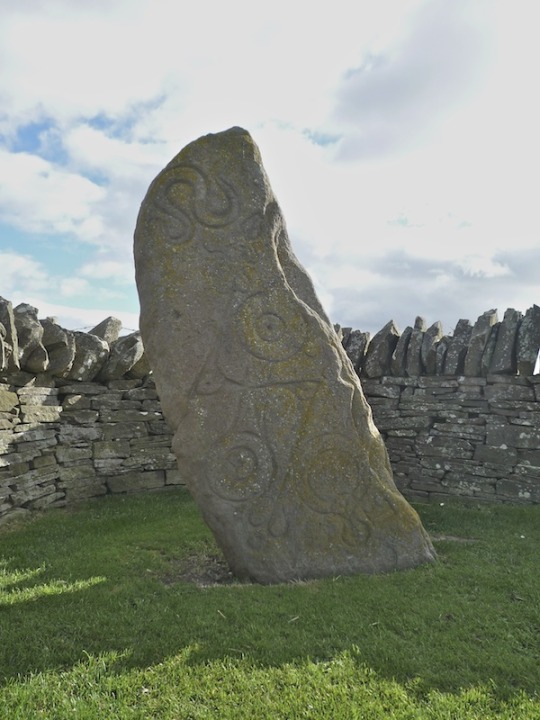
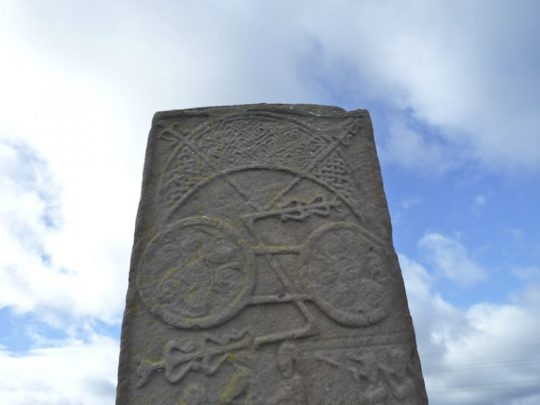

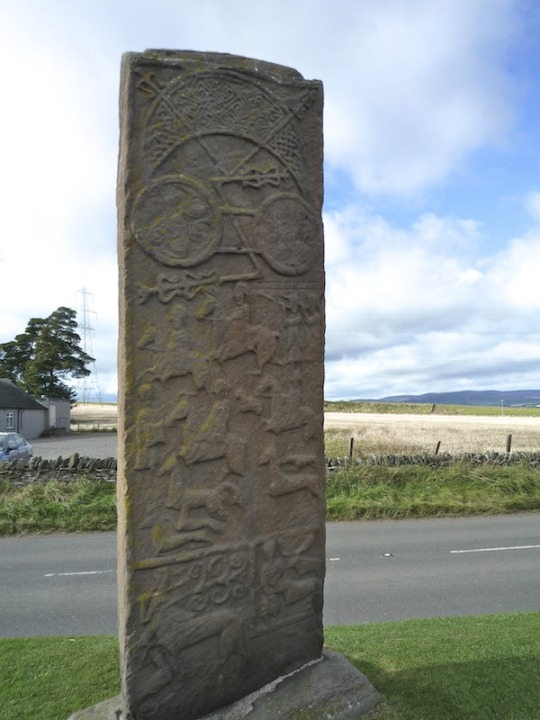

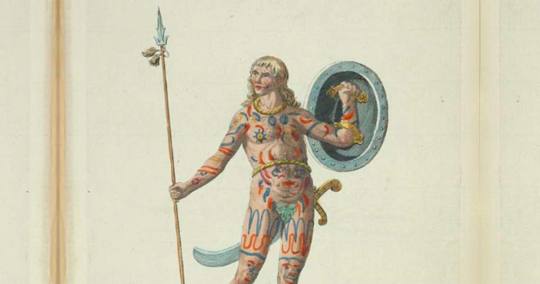
On 20th May 685 The Picts won a decisive Battle , in present-day Angus, known as The Battle of Dun Nechtain or Battle of Nechtansmere.
A wee bit longer post than I normally give you, but it is a great story, the first part tells us how a battle against The Angles helped shape the country we now know as Scotland, the second is a tale from the twentieth century, both stories are connected, read on and enjoy.........
Known as 'Picti' by the Romans, meaning 'Painted Ones' in Latin, these northern tribes constituted the largest kingdom in Dark Age Scotland. They repelled the conquests of both Romans and Angles, creating a true north-south divide on the British Isles, only to disappear from history by the end of the first millennium - swallowed whole by the history of another group, the Gaels. Together they created the Kingdom of Alba.
The Picts took part in one of the most decisive battles in Scottish history - the Battle of Dun Nechtain (Dunnichen). If the Picts had lost, Scotland might never have existed. For the Angles of Northumbria it was simply a disaster - ending their domination of Scotland.
The Battle of Dun Nechtain was fought on this day in 685 AD and is one of the best recorded events in Dark Age Scotland.
The Kingdom of the Angles under King Oswui had rapidly expanded north, moving their frontier from the River Forth to the River Tay. Since 653 AD many of the major groups of people in Scotland - Britons, Gaels and much of Pictland - had been subject to the overlordship of King Oswui. In 672 AD, after the death of Oswui, the Picts rose against their overlords, expelling Drust, their Northumbrian puppet king.
The new King of Northumbria, Ecgfrith, wasted no time in wreaking revenge on the Picts. The Picts were massacred at a battle near the town of Grangemouth, where the rivers Carron and Avon meet. According to Northumbrian sources, so many Picts died they could walk dry-shod across both rivers. By 681 AD Ecgfrith had founded a bishopric at Abercorn on the southern shore of the Forth - a symbol of Northumbria's secure grip over the Picts.
The defeated Picts took Bridei, son of Bili, as the king of a much depleted Pictland. King Bridei was actually the cousin of his mortal enemy, King Ecgfrith of the Angles, but, in true Dark Age fashion, this didn't diminish their mutual desire to destroy each other. An almighty battle was on the cards.
The Chronicle of Holyrood gives us an account of the battle: "In the year 685 King Ecgfrith rashly led an army to waste the province of the Picts, although many of his friends opposed it...and through the enemy's feigning flight he was led into the defiles of inaccessible mountains, and annihilated, with great part of his forces he had brought with him." However, we need to keep in mind this account was written hundreds of years after the event.
The Angles were advancing up Strathmore, probably aiming for the Pictish fortress of Dunnottar, when they fell into Bridei's trap. Sighting a Pictish warband, the Angles set off in pursuit, then, as they came over the cleft in Dunnichen Hill, they found themselves confronted by the main body of the Pictish army. Caught between the Picts and the loch below the hill, the Angles bravely faced their doom.
The politcal map was altered. The Picts, Gaels and many Britons were freed from Northumbrian overlordship. Gaelic poets as far away as Ireland celebrated the battle's outcome. The Pictish frontier returned to the River Forth near Edinburgh and the Bishop of Abercorn fled, never to return. The Angles never fully recovered as major force in Scotland.
It is no coincidence that the Picts mysterious disappearance occurs at the same time as the creation of the kingdom of Alba. For many years Gaelic influence in Pictland had been on the rise. The Gaelic religion of Christianity had spread throughout Pictish lands and with it many Gaelic traditions. Furthermore, through a mixture of conquest and inter-marriage Gaelic or Gaelicised royalty had succeeded to the Pictish throne (a notable example of this being Kenneth MacAlpin).
Finally in 878 AD the Pictish king, Áed, was murdered and replaced by a Gael - Giric. Giric accelerated the Gaelic takeover of Pictish politics during his reign making the Gaelic language and traditions commonplace. Even after Giric was finally deposed in 889 AD future Pictish kings such as Donald and Constantine embraced Gaelic culture. By 900 AD Pictland ceased to exist. The reign of Donald is listed in the Chronicle of the Kings of Alba as a king of Alba. Pictland and Dál Riata had gone and in their place Alba - a Gaelic word for Scotland - was created. In this simple listing in an obscure book Scotland has its origins.
Fast forward over 12 hundred years to the 2nd January 1950, and a woman called Miss E.F. Smith, described as a spinster, was driving home from a party in Brechin at about 2am. Her car had skidded into a ditch 2 miles outside the area due to the treacherous road conditions. She still had another 8 miles to go so she continued her journey on foot. She felt oddly nervous as she walked along the minor road west of the A932, then she saw a number of strange lights in the distance near Dunnichen Hill. Turning south towards the village, she noticed figure in the field to her right, part of Drummietermont Farm. Each figure carried a flaming red torch in its left hand and they seemed to be searching the ground for something.
Miss Smith then saw shapes on the ground exactly like dead bodies. The figure nearest to her stooped down and examined several of these ‘corpses’, turning them over and back again, as if looking for recognisable faces. This scene lasted for around ten minutes, with Miss Smith’s dog barking throughout. Eventually she simply walked away. She only realised that the whole event was peculiar when she woke up next day and thought about it. Later she gave details of the experience to the Society for Psychical Research. She reported that the searchers wore garb like body stockings, along with tunics and flattened oval helmets. They appeared to be moving around the edge of the vanished mere, the shape of which was later traced by archaeological investigation.
Although this post battle manifestation has not been repeated. some motorists passing through Dunnichen on misty nights have caught sight of fleeting human forms which vanish before their cars hit them.
There is some skepticism as to how real Miss Smith’s sighting was. She was travelling very late at night and had already walked a number of miles, not to mention suffering a trauma from skidding her car into a ditch. The vision could have been brought about as a result of exhaustion and the effects of the cold. However, the fact that it occurred at the exact site of the Battle of Nechtansmere seems to be too much of a coincidence and it is unlikely that the woman’s dog would react to something that occurred only in his owner’s mind.
The pictures are of Pictish stones from around Aberlemno that perhaps tell the story of the battle.
86 notes
·
View notes
Text
Ykw? I like you :D
Gijinkas your bishops

Jk- I wanted another excuse to give out more headcanons I had for them. They look a bit lazy cause my hand is going nuts :’D it hurts-
I’m gonna add a few more that didn’t fit plus add a bit as to their inspirations!

Leshy’s a bit sad, but that’s what happens when your brother tries to kill you young. I like to think that he doesn’t want anyone to figure out he’s a Bishop, so he dresses similarly to his followers to confuse newcomers who may try to kill him. Leshy reminds me of Fallout, so yeah, it made sense in my head. He doesn’t cover his eyes in Darkwood since it blows his cover, he does around family and when he’s indoctrinated.

I use markings a lot with my ocs to portray status. She has different markings compared to her followers so others would know she’s in charge. In the early days, she did used to sing in her temple’s pub :) it was fun for her. I like to think that Anura is colder so she would dress in layers. My Sozo design also shows this! His tribe was originally in Anura and they were once followers of Heket before it was raided. Funny enough- I based her outfit on the water tribe in Avatar- but she looks like the fire nation- ha-

Kallamar tried his best to help with Leshy- but his fear of water made it hard. They tried not taking it personally, but it hurt :( Leshy used to love being in Anchordeep to see the gemstones. Kal restored to covering Silk Cradle’s ceiling with the stones, and when Leshy took Darkwood, he covered his temple in green stones. Kallamar loves beauty- similar to pink diamond in Steven Universe- but more fucked? All his followers are dressed in jewels and the finest clothes that the tailors make. (Wings of fire fans- book 12 with jewel hive? Like that- exactly like that)

Shamura wears a veil because of their eyes, they’re always diluted. It helps them with their sensitivity to the light. But when they’re not lucid- they use to out of shame. Ever since the betrayal, their followers never seen a clear view of their face. They’re responsible for Narinder’s actions and causing Leshy’s trauma. Their blood was what caused it in the first place :( The similarities to Shamura with the Pale King is insane though. Their followers are devoted to someone who is a shell of who they once were. All their followers wear dark clothes to help with their sensitivity and veils to avoid eye contact. It makes sense in my head-
Sorry for the long ramble :D but I wanted to ramble and draw gijinkas
#bloo’s art :)#cult of the lamb#cotl bishops#cotl kallamar#cotl heket#cotl leshy#cotl shamura#gijinka#headcanons#I’ll do Emery and Narinder when my hand feels better#My hand hurts like hell :’D AAAAAA#but we ride at dawn#you can tell where I started rushing though#I’m sorry#:’D
44 notes
·
View notes
Text
"The reign of Commodus marked the end of the Golden Age and the beginning of the age of iron and rust". Cassius Dio

Lucius Aelius Aurelius Commodus was born on August 31, 161. Curiously, he was born on the same day and month as 'Caligula', the first assassinated Roman emperor. Commodus was the first emperor to be born the son of the reigning emperor Marcus Aurelius.
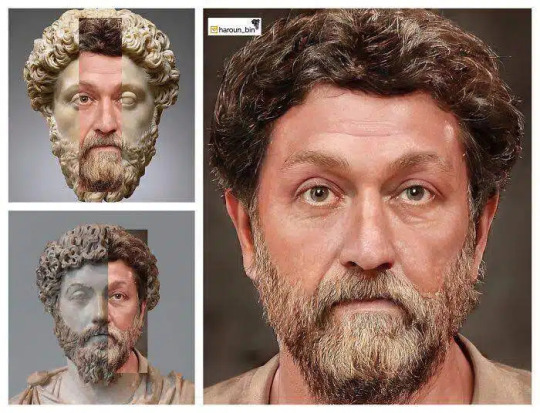

Marcus Aurelius and Lucius Verus ruled together in perfect cooperation for eight years. Verus fought against the Parthians who had threatening to take Syria and Armenia. Returned to Rome and had his triumphal parade without knowing that he and his legions were carrying a virus that arose in the war zone. The plague spread throughout the empire and was the deadliest in Roman history. In 169 Lucius Verus died due this plague.
The boy Commodus
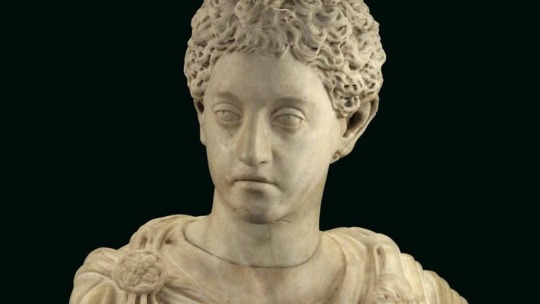
In 172, at age of 11, he received, in the presence of the army in Germania, the title Germanicus (a victory tittle). He participated alongside his father in several battles.
175. His mother, Empress Faustina the Younger, died of natural causes in Cappadocia where she accompanied her husband. On the same year Commodus entered the College of Pontiffs, which was the starting point of his public career.
176. Marcus Aurelius granted him the position of Imperator, and the following year the title Augustus.
In January of 177, at the age of 15 , he became the youngest consul in the history of the Empire.
178. At age of 16 married to Bruttia Crispina, a very rich 13 year old girl from a family close to the imperial Domus since the time of emperor Hadrian.
March 17, 180, Marcus Aurelius died of natural causes and Commodus became sole emperor at the age of 18.
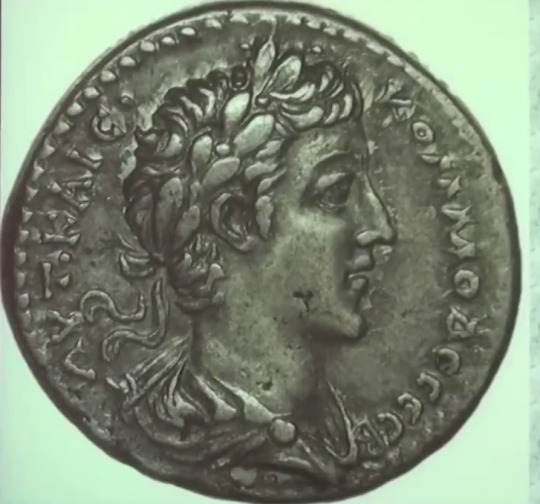
His first measure was to sign peace treaties both with Germanic tribes and some rebellious people of Britannia. This was frowned upon by his contemporaries, but modern historians agree that it was the only good action he ever took during his entire reign.
About his sister.

Lucilla had been co-empress and held the title Augusta along with her mother when she married the co-emperor Lucius Verus. Following Verus' death, Marcus Aurelius married her to senator Tiberius Pompeianus, a man of humble origins and without ambitions. In this way she lost the privileged position that she had.
In the winter of 181-182 Lucilla with her cousins Quadratus Annianus and Ummidia Faustina, her husband's nephew, Quintianus, and her own daughter Plautia, agreed to assassinate Commodus in the exit hallway of Flavian amphitheater (Colosseum) .The one chosen to kill was Quintianus. Incredibly, although proven, Pompeianus was completely unaware of the plot of his wife.

According to historical sources, when Quintiano saw Commodus, instead of stabbing him, slowly took out his dagger, showed it to him and said "The Senate send to you this dagger." Commodus shouted for his guard who immediately arrested him. The names of the involved were quickly known; Quintianus and Quadrato were executed. Lucilla, her daughter, and U. Faustina were sent into exile on Capri but and also executed there.
Following this event, he distanced himself from the elite and began to trust only in people of humble origins, among them Marcus Aurelius Cleander, former slave and freedman of Marcus Aurelius. In a short time he held important positions until he became the head of the Praetorian Guard.
In 187 due his wife's failure to become pregnant, banished her to Capri. 26-year-old Commodus, instead of marrying another aristocratic woman, chooses to have a concubine- Marcia, daughter of a freedwoman of co-emperor Lucius Verus.

The emperor treated her as a wife, so she had the same power and influence as an empress. It is very probable that Marcia was a Christian since she convinced Commodus to implement a pro-Christian policy, and had a close relationship with Victor I , Bishop of Rome.
Villa of the Quintilii and the rebellion of the people.

Commodus and Marcia retired to the lavish Villa of the Quintilii, whose ruins are today an archaeological site. On April of 190 the people had revolted in Rome because of famine.
There is a suspicion that the shortage of food may have been caused by the prefect of Annona (the import and free distribution of grain to the people) Papirius Dionysius who blamed Cleander.
During a horse-race in the Circus Maximus, the audience to rioted against Cleander. He escaped and managed to reach the Villa of the Quintilii to ask the emperor for help, but the mob followed him there. Commodus, fearing the fury of the people, ordered Cleander to be beheaded. He then also ordered the execution of the prefect of Annona Papirius Dionysius.

By then Commodus was already showing signs of an extreme megalomania and paranoia. The list of people executed, accused without evidence of conspiracy, including his own aunt, consuls, senators and praetorians, is endless. Those conspiracies were only in his mind.
He gave himself the title PIUS, title that the Senate had granted to his maternal grandfather the Emperor Antoninus, also added the tittle Felix, and ordered sculptures and busts of himself to be made representing him as Hercules.
Madness and death
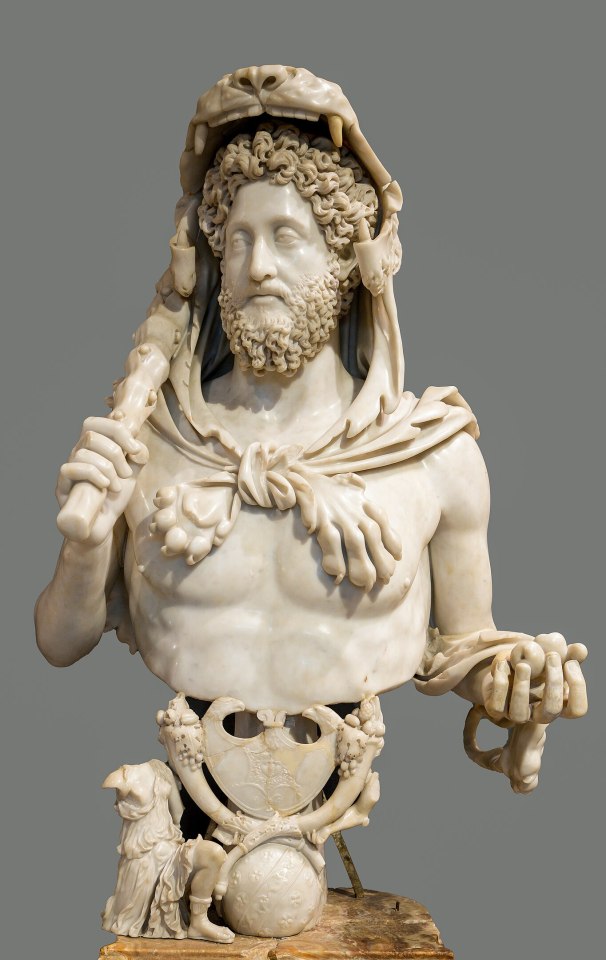

He changed the name of Rome to "Comodiana" and announced that a new era was approaching, he called it Saeculum Felix (Happy Century). All months also was renamed with Commodus own names and titles as well of his dynasty; Not even the mystical month of July was saved from this folly.
According to historical sources, he had shaved his beard, which had been in fashion since his grandfather's time, and also changed his thick curly hair for Gladiator curt hair style. Had his own games in which he fought with gladiators, who were forced to consume opium and drink wine excessively to ensure the victory of Commodus.
On December he announced that starting in the new year everything would change in Rome. The final plot to assassinate Commodus began.
The two leaders of the conspiracy was Publius Helvius Pertinax (son of a freedman) prefect of the city of Rome, and the commander of the Praetorian Guard, Quintus Aemilius Leto.
They used as executioners the two people closest to Commodus: his concubine and a freedman athlete named Narcissus, who had trained him as a gladiator, taking advantage of the fact that Marcia was fed up with Commodus and Narcissus was furious at the cheating he had seen during fights against drugged gladiators with dull swords.
During the feast of December 31, Marcia put poison in his food, but Commodus had drunk too much and vomited immediately, so he ended the party and ordered that his bath be prepared.
Then Pertinax and Leto sent Narcissus, who "due to his size and strength he did not need to hide daggers or swords, his hands were enough" (Cassius Dio). Narcissus found emperor in the bathtub and strangled him. Commodus was 31 years old.

On January 193, know as "The year of the five emperors", Praetorian Guard auctioned the throne to the highest bidder; The final price was stipulated at 25,000 sesterces per soldier. Pertinax bought the position of emperor but on March he was also murdered. Then Didius Julianus ruled for a few days, he was assassinated by a soldier.
Pescennius Niger, governor of Syria, Clodius Albinus, governor of Britain, and Septimius Severus, governor of Pannonia, proclaim themselves emperors. The winner of this civil war for imperial power was Septimius Severus. It was the second civil war of the Roman imperial era.
Septimius Severus ,who ruled for 18 years , became the first emperor originally from the province of Africa. Born in Leptis Magna (in modern Libya) was of Berber and Punic origin, and with his wife Julia Domna, a young noblewoman born in Syria and Arab origin, they created the Severan Dynasty.
Commodus was not wrong when he said that from that year on everything would change in Rome.

64 notes
·
View notes
Text
❝ MASTERLIST ❞
Welcome to this blog's masterlist of original writing.

Beware that most of the works here are gxg based with female characters, actresses or singers. I do not intend to assume no real person's sexuality, nor do I intend to follow canon page by page.
Some works from wattpad are to be posted here.
Requests are open (in any way you may see fit), but I do only write for the following list:
[🛑] = Works ready and posted on wattpad that will be posted here soon.
🌸 = Fluffy
⛈️ = Angst
🌹 = +18
ㅤ ⎯⎯⎯⎯⎯⎯⎯⎯⎯⎯⎯⎯⎯⎯⎯ㅤ
WEDNESDAY

WEDNESDAY ADDAMS
ㅤ Wednesday Addams x Reader
➤ nothing yet!
ㅤ Wednesday Addams x Original Character
➤ nothing yet!
ㅤ ⎯⎯⎯⎯⎯⎯⎯⎯⎯⎯⎯⎯⎯⎯⎯ㅤ
THE WHEEL OF TIME

MOIRAINE SEDAI/DAMODRED
ㅤ Moiraine Sedai x Reader
➤ nothing yet!
ㅤ Moiraine Sedai x Original Character
➤ Found | Found² [⛈️🌸]
➤ Remeant [🛑]
ㅤ ⎯⎯⎯⎯⎯⎯⎯⎯⎯⎯⎯⎯⎯⎯⎯
ONCE UPON A TIME

REGINA MILLS
ㅤ Regina Mills x Reader
➤ nothing yet!
ㅤ Regina Mills x Original Character
➤ nothing yet!
ㅤ ⎯⎯⎯⎯⎯⎯⎯⎯⎯⎯⎯⎯⎯⎯⎯

EVIL QUEEN
ㅤ Evil Queen x Reader
➤ nothing yet!
ㅤ Evil Queen x Original Character
➤ nothing yet!
ㅤ ⎯⎯⎯⎯⎯⎯⎯⎯⎯⎯⎯⎯⎯⎯⎯
MARVEL

WANDA MAXIMOFF/THE SCARLETT WITCH
ㅤ Wanda Maximoff x Reader
➤ nothing yet!
ㅤ Wanda Maximoff x Original Character
➤ nothing yet!
ㅤ ⎯⎯⎯⎯⎯⎯⎯⎯⎯⎯⎯⎯⎯⎯⎯

AGATHA HARKNESS
Agatha Harkness x Reader
➤ To Mend a Soul [⛈️🌸]
➤ I will remain, Love. [⛈️🌸]
➤ In Between [🌸]
➤ Her Peacemaker [🌸]
➤ Three of Swords . [⛈️🌸]
➤ My Love? [🌸]
Agatha Harkness x Original Character
➤ nothing yet!
ㅤ ⎯⎯⎯⎯⎯⎯⎯⎯⎯⎯⎯⎯⎯⎯⎯

RIO VIDAL/LADY DEATH
Rio Vidal x Reader
➤ nothing yet!
Rio Vidal x Original Character
➤ nothing yet!
ㅤ ⎯⎯⎯⎯⎯⎯⎯⎯⎯⎯⎯⎯⎯⎯⎯

AGATHARIO X READER/ORIGINAL CHARACTER
➤ nothing yet!
ㅤ ⎯⎯⎯⎯⎯⎯⎯⎯⎯⎯⎯⎯⎯⎯⎯

KATE BISHOP
ㅤ Kate Bishop x Original Character
➤ nothing yet!
ㅤ ⎯⎯⎯⎯⎯⎯⎯⎯⎯⎯⎯⎯⎯⎯⎯
ACTRESSES

ROSAMUND PIKE
➤ It was enchanting meeting you. [🛑]
➤ It was enchanting meeting you². [🛑]
➤ The best thing that's even been mine. [🛑]
➤ Afterglow. [🛑]
➤ Afterglow². [🛑]
➤ Afterglow ³. [🛑]
➤ Golden like daylight. [🛑]
➤ Your voice. [🛑]
➤ Falling in love in the cruelest way. [🛑]
➤ It takes a tribe. [🛑]
ㅤ ⎯⎯⎯⎯⎯⎯⎯⎯⎯⎯⎯⎯⎯⎯⎯

HAILEE STEINFELD
➤ Call it what you want. [🛑]
ㅤ ⎯⎯⎯⎯⎯⎯⎯⎯⎯⎯⎯⎯⎯⎯⎯
#wednesday x reader#moiraine x reader#wanda maximoff x reader#jenna ortega x reader#wednesday addams x reader#regina mills x reader#hailee steinfeld x reader#kate bishop x reader#rosamund pike x reader#rosamund pike#moiraine damodred#moiraine sedai#moiraine sedai x reader#moiraine damodred x reader#ouat#evil queen x reader#gxg#fanfiction#dnightshade masterlist#agatha harkness x reader#agathario#rio vidal x reader#agatha harkness
49 notes
·
View notes
Text
Ways English borrowed words from Latin
Latin has been influencing English since before English existed!

Here’s a non-exhaustive list of ways that English got vocabulary from Latin:
early Latin influence on the Germanic tribes: The Germanic tribes borrowed words from the Romans while still in continental Europe, before coming to England.
camp, wall, pit, street, mile, cheap, mint, wine, cheese, pillow, cup, linen, line, pepper, butter, onion, chalk, copper, dragon, peacock, pipe, bishop
Roman occupation of England: The Celts borrowed words from the Romans when the Romans invaded England, and the Anglo-Saxons later borrowed those Latin words from the Celts.
port, tower, -chester / -caster / -cester (place name suffix), mount
Christianization of the Anglo-Saxons: Roman missionaries to England converted the Anglo-Saxons to Christianity and brought Latin with them.
altar, angel, anthem, candle, disciple, litany, martyr, mass, noon, nun, offer, organ, palm, relic, rule, shrine, temple, tunic, cap, sock, purple, chest, mat, sack, school, master, fever, circle, talent
Norman Conquest: The Norman French invaded England in 1066 under William the Conqueror, making Norman French the language of the state. Many words were borrowed from French, which had evolved out of Latin.
noble, servant, messenger, feast, story, government, state, empire, royal, authority, tyrant, court, council, parliament, assembly, record, tax, subject, public, liberty, office, warden, peer, sir, madam, mistress, slave, religion, confession, prayer, lesson, novice, creator, saint, miracle, faith, temptation, charity, pity, obedience, justice, equity, judgment, plea, bill, panel, evidence, proof, sentence, award, fine, prison, punishment, plead, blame, arrest, judge, banish, property, arson, heir, defense, army, navy, peace, enemy, battle, combat, banner, havoc, fashion, robe, button, boots, luxury, blue, brown, jewel, crystal, taste, toast, cream, sugar, salad, lettuce, herb, mustard, cinnamon, nutmeg, roast, boil, stew, fry, curtain, couch, screen, lamp, blanket, dance, music, labor, fool, sculpture, beauty, color, image, tone, poet, romance, title, story, pen, chapter, medicine, pain, stomach, plague, poison
The Renaissance: The intense focus on writings from classical antiquity during the Renaissance led to the borrowing of numerous words directly from Latin.
atmosphere, disability, halo, agile, appropriate, expensive, external, habitual, impersonal, adapt, alienate, benefit, consolidate, disregard, erupt, exist, extinguish, harass, meditate
The Scientific Revolution: The need for new technical and scientific terms led to many neoclassical compounds formed from Classical Greek and Latin elements, or new uses of Latin prefixes.
automobile, transcontinental, transformer, prehistoric, preview, prequel, subtitle, deflate, component, data, experiment, formula, nucleus, ratio, structure
Not to mention most borrowings from other Romance languages, such as Spanish or Italian, which also evolved from Latin.
Further Reading: A history of the English language (Baugh & Cable)
160 notes
·
View notes
Text
WAIT DRAKA A GIRL?? Never even occurred to me that she wouldn’t be a guy when we saw her visuals released lol. I’m guessing her tribe are Romani since they seem to be ostracised from society, darker skin and a strong emphasis on collectivism?


Bitch ass mf of the year award goes to her uncle holy shit what a scumbag. Not only was he a massive hypocrite for getting upset at Draka wandering off from the campsite since he was doing the same in the wine cellar, BUT he also sold out his own niece and village to Antoni to escape. His own flesh and blood after talking all that shit about her looking out for him all these years and being her only relative. It be ya own people


You know how shitty a human being you have to be to not be the worst person in a room with Antoni??? Speaking of Antoni I guess he did get that promotion to bishop and is still the most unholy thing around. Selling people into slavery, killing trespassers without even getting the full story and threatening villages, very Christ like!

While Draka uncle sold her out because of cowardice and evil, it might be the best gift he’s ever given her since she found Oczy’s book thus keeping the heliocentric dream alive and potentially being a big money maker lol. Great, but hard to watch ep.





#animangahive#animanga#animanga hive#anime#orb anime#orb: on the movements of the earth#chi: chikyuu no undou ni tsuite#orb
19 notes
·
View notes
Photo

Saint Cyril
Saint Cyril (aka Kyrillos and Constantine the Philosopher, d. 867 CE) was a Byzantine linguist, teacher, scholar and missionary who famously preached Christianity to the Slavs in Moravia with his brother Methodius during the 9th century CE. He created the Glagolitic alphabet, the forerunner to the Cyrillic alphabet that bears his name, and did much to spread the religion, art and culture of the Byzantine empire into central Europe.
Early Life
Cyril is the monastic name the saint chose near the end of his life but he was born Constantine, the son of a military officer called Leo stationed in Thessaloniki; his mother may have been a Slav. He was a gifted linguist from an early age and was sent to Constantinople to further his education and study such languages as Syriac and Hebrew. Looked after by the eunuch Theoktistos, Cyril was ordained as a priest and served as an official at the Hagia Sophia church where he developed a close relationship with the Patriarch of Constantinople, the bishop Photios. The brilliant scholar quickly became the bishop's librarian. Cyril became a teacher of philosophy at the Magnaura university in Constantinople where he gained the epithet “Constantine the Philosopher”.
Cyril was next sent on two diplomatic missions, the first to the Muslim court at Samarra and the second to the Khazars, a Turkic tribe in the Caucasus, c. 860 CE. According to Cyril's 9th century CE biography, attributed to one of his disciples, the scholar monk was enthusiastic for the opportunity to spread the Gospel:
If you command, lord, on such a mission I shall gladly go on foot and unshod, lacking all the Lord forbade Hi disciples to bring.' The emperor answered, saying,: 'Well spoken, were you to do this ! But bear in mind the imperial power and honour, and go honourably and with imperial help.
Life of Constantine (in Shepard, 315)
The trip, unfortunately, ended in failure if it had intended to convert the Khazars to Christianity as the Byzantines only managed to baptise around 200 of them. The Khazaria state eventually adopted Judaism instead. Cyril did bring back souvenirs, though, said to be the relics of the exiled 1st century CE Bishop of Rome, Saint Clement. His ambitions were not dampened either as he promptly set off of his own accord into the Crimea to spread his message to the heathen Phoullai people. It is likely Cyril was not any more popular there, though, especially when he chopped down their sacred oak tree.
Continue reading...
30 notes
·
View notes
Text

St. Declan of Ardmore
350-450
Feast day: July 24
Patronage: Ardmore, Ireland, The Dioceses of Waterford and Lisman
Saint Declan was born a prince of the Decius (the ruling class) tribe of Celts. Baptized by St. Colman, he was the first person to bring Christianity to Ireland, before St. Patrick, though only locally. He was the bishop of Ardmore and established a monastery there. His well, known as “the waters of St. Declan”, still has healing properties. St. Patrick and St. David of Wales considered him as a friend. He died “in a narrow place beside the sea” called Declan’s Desert. Local Catholics celebrate his feast day, called his “pattern” on July 24.
Prints, plaques & holy cards available for purchase here: (website)
43 notes
·
View notes
Text
WOLFER --- The real California history behind the Tomione Fic
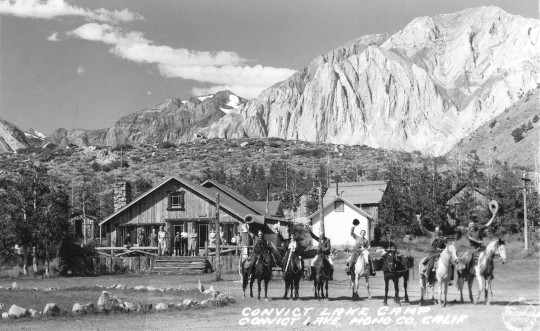
Convict Lake Camp (OwensValleyHistory.com)
When I was a kid, my family frequently visited Bishop, California. I can still feel the light-headed enchantment of hopping out of the van at a relative's green, creek-watered ranch shadowed by towering granite faces of the High Sierras. The dusty road and sage-sharp aroma propelled my imagination two hundred years into the past.
Wolfer is set in 1890 Bishop Creek, and while some of the location names are changed to fit the story, the town really had ranching barons like the Sacred 28 families, churches which exerted certain levels of social power with the well-to-do folk, boarding houses for mill workers and on-farm worker housing for fruit pickers and cowboys--or perhaps the odd wolfer.
It's amazing what you can dig up when you're procrastinating working on your WIP, lol. I did a lot of initial research while writing a Gingerrose fic set in post Civil War Bishop Creek.
Here are some things I found.
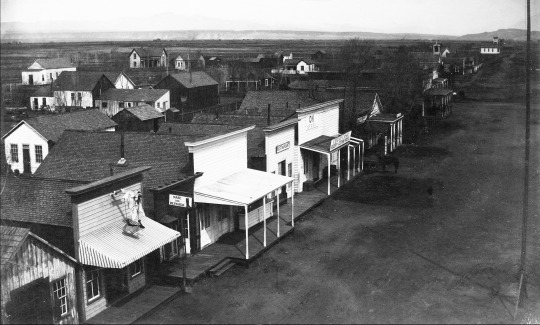
Main Street, Bishop Creek 1880 (OwensValleyHistory.com)
In Chapter 1, Tom rides down Main Street to the marshal's office (played by a grudging Severus Snape) and runs into Hermione.
Way off into the upper right you can see the steeple of the First Baptist Church on Main Street.

East Line Street, Bishop Creek (OwensValleyHistory.com)
Tom chases Hermione to Line Street, where he pushes her up against the Brown's Machine Shed, which is of course re-named to fit Lavender Brown's family.

(OwensValleyHistory.com)
Check out that snow! Sitting at 4,000 feet of elevation in the foothills of the East Sierras, the snow can get quite voluminous.

W.D. Roberts Ranch, Round Valley (OwensValleyHistory.com)
The ranch near the dry saltbeds of Owens Lake where Draco visits Harry, (by way of Mad Eye Moody) might have looked like this.

Cerro Gordo photo taken some time between 1871 - 1879 (OwensValleyHistory.com
We get a brief glimpse of the Cerro Gordo silver mine when Draco and Harry ride off into the sunset together for a night of wild debauchery. The brothels and bawdy houses within these sprawling mining towns would have perhaps been some of the only public places for late 19th-century gays to be themselves. Miss Lola's was among the more famous, and I'm struggling to find the website where I originally learned this this but I believe she hosted queer sex workers and provided space for an early LGBTQ+ scene.
The silver mine itself brought together a richly diverse group of fortune seekers. I accessed California census documents and found that while Bishop Creek was mostly white, Cerro Gordo had a much more diverse population (interestingly all marked with 'I', even Latinx names).
I did a phone interview with the Inyo Historical Society and chatted for an hour with a local historian, telling him I was getting context for a novel. (He didn't need to know that my novel was also a fanfic, hahaha.) The historian told me the mine had Mexican, Black, Chinese, and Indigenous populations working as miners, teamsters (people who drive wagons), cooks, brick masons, farm laborers and all kinds of interesting jobs related to running the mine.

Main Street in Bishop Creek, 1878 (OwensValleyHistory.com
One thing that sticks out in my mind from the conversation with the historian is how the white and Mexican ranchers demolished the irrigation canals the Numuu Indigenous tribes had dug to create a green landscape in Owens Valley. Native Americans have been 'farming' America's landscape for thousands of years in a low-impact way. In Chapter 4, Tom muses on this detail as he's setting a wolf trap on Rosier's ranch.
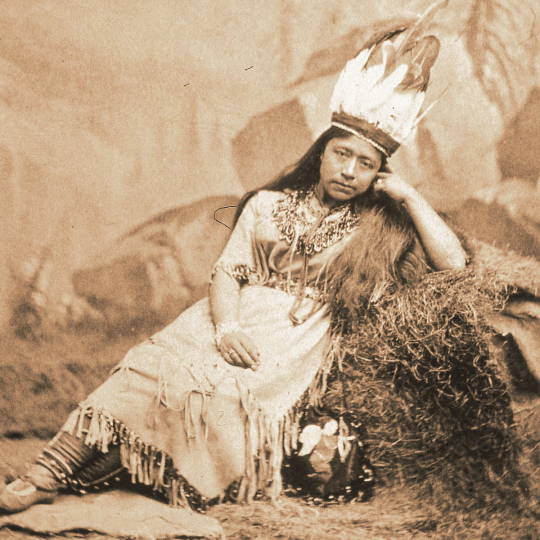
Perhaps the most illuminating account of the region comes from Sarah Winnemucca, daughter of Chief Truckee (after whom the town is named). Sarah travelled as an advocate for Indigenous rights and cataloged her experience and the story of white settler colonization in her book, Life Among the Pauites: Their Wrongs and Claims which you can read for free here.
Thank you for diving into California history with me!
Read Wolfer here.
30 notes
·
View notes
Text
Frau Holle
This essay is seven thousand words long and English is not my native language so please forgive me if there are grammatical or spelling mistakes in the text. I have also moved some passages arround so let's hope that I didn't accidentally leave doublets in this text
Most likely "Holle" (meaning "the Benevolent") was originally an epithet for the Germanic goddess Frigg. Following Christianization, this name became distinct, partly due to prohibitions against invoking pagan goddesses, which were now considered evil beings. Similarly, Perchta (meaning "the Shining One") in the southern German and Alpine regions may have derived from another name for Frigg, influenced by specific local Noric traditions. Related figures to Frigg/Perchta/Holle could also be Frau Harke or Harre. The name of Frau Holle's appears most frequently in the ereas arround Hesse, Thuringia, and Lower Franconia Further south, she is called Berchta/Perchta, while in the north, she is referred to as Frau Frerk (after Frigg/Frea/Frija) or Frau Wode, Frau Gode, named after Friggs husband: the god Odin. (The Old Norse theonym Odin and the high-german/dutch Wode/Woden/Gode are all derived from the Proto-Germanic masculine theonym „Wōðanaz“)
Frau Holle is also identified with the goddess Holda or Hulda, potentially another Germanic name for Frigg.
It is also possible that she is connected tot he Germanic death goddess Hel. Frau Holle is also associated with the fertility goddess Freyja. People who are familiar with Norse mythology will probably have heard the theory that Freyja and Frigg may have been one and the same goddess, but we don't have enough sources to determine this. And if Frigg and Freyja are derived from the same figure then it is still unclear whether this was just a later devolepment in the scandinavian countries while the continental Germanic Freyja/Frigg remained a single entity. Since the Continental Germanic tribes were Christianized earlier than the Scandinavians, we have even fewer sources on Continental Germanic mythology than on Norse Germanic mythology. The few Roman sources about the religion of Germania, for example, do not reveal anything about the existence of Loki, so it could be that Loki is a late addition to the phantheon, that he only gained importance later or that he only appeared in North Germanic mythology. Even if North Germanic and Continental Germanic mythology come from the same proto-mythology, both probably had different local deities and perceived their shared deities differently. In any case, the existence of Frau Holle indicates that Frigg/freyja held a more important position in Continental Germanic mythology than in Norse Germanic mythology. The continental Germanic Freyja/Frigg was equated with the Roman goddess Dianah, which is why it can be assumed that the continental Germanic Frigg was not only thought of as the wife of Odin but was also regarded as a young single goddess. Frau Holle is nowhere mentioned with a husband, but unlike Dianah, she is never explicitly associated with the concept of virginity. Frau Holle dosent have a husband but she isnt a virgin either. She is connected with the domestic duties of a house wife but in an supernatrual, ruler-of-the-universe-kind-of-way. Connections to Odin still exists though: during the Rauhnächte frigg is said to ridewith Wotan through the clouds, symbolizing winter storms and Frau Holle is sometimes said tob e the supreme leader oft he wild hunt
Written traces of Frau Holle can be followed back at least 1,000 years, with the earliest mention in the decrees of Bishop Burchard of Worms, written between 1008 and 1012. However, her roots go much further, stating, The evidence strongly suggests that Frau Holle is not a ghostly figure or a vegetation spirit but the regional embodiment of an ancient Earth Goddess. One of these manuscript documents, the 'Summa fratris Rudolfi de confessionis discretione', written between 1235 and 1250 by a Cistercian monk named Rudolf, is particularly interesting in terms of its content, as it refers to the myth of setting the table for Frau Holle in the Rauhnächten collected by Paetow.
The manuscript states:
“Certain women, in order to become happy and be successful in worldly matters, indulge in god-hating fantasies: On Christmas night, they set the table for the Queen of Heaven - whom the people call Frau Holle - so that she may help them.”
This statement points to a cult of Holle that still existed in the early 13th century, although it was viewed with suspicion and condemned by the church. As early as the beginning of the 11th century she appears to have been known as the leader of women, and of female nocturnal spirits, which "in common parlance are called Hulden from Holda". These women would leave their houses in spirit, going "out through closed doors in the silence of the night, leaving their sleeping husbands behind". They would travel vast distances through the sky, to great feasts, or to battles amongst the clouds. A 16th century fable recorded by Erasmus Alberus speaks of "an army of women" with sickles in hand sent by Frau Hulda. Thomas Reinesius in the 17th century speaks of Werra of the Voigtland and her "crowd of maenads."
In ancient times, the Germanic Chatti (or "Hessians") may have offered pagan sacrifices to their beloved goddess atop the mountain Hoher Meißner, as suggested by archaeological findings of gold coins from the first century AD.
Holle’s connection to the three worlds (Underworld, Upperworld, and Earthly realm) also suggests a role as a Germanic shamanic goddess, making the fairy tale read as an ecstatic initiation rite. Through the well (axis mundi), the initiates symbolically embark on a spiritual journey. In addition to literary accounts, folk customs associated with Frau Holle, bearing archaic features and shamanic elements, continue to the present day. For instance, in southern Germany during the Perchtenlauf (or Holle Run), wild men and women parade to drive out winter spirits and summon spring; their animal costumes with fur and horns recall Paleolithic cave paintings of shamans, clad in animal skins, performing ritual dances in honor of the numinous Mother of Animals.
During the christianasation, direct mention of Frigg or Diana became less acceptable. Thus, the common folk began referring to her obliquely as Hulda, Holde, or Holle.
In the eyes of the Church, she soon became a “she-devil.”
And so the radiant wife of Wotan faded from prominence, surviving only in the shadows of superstition. And since Frau Holle was associated with womanhood, she soon became a witch goddesses.Grimm describes Holle as an ancient sorceress and witch-goddess, noting that witches travel in Holle’s company and ‘Holle Riding’ in Upper Hesse and the Westerwald is synonymous with a witches' ride.”However, she was never as demonized as Frau Perchta bacame in the Alpine regions.
Her center of worship was/is a mountain massif Hoher Meissner. The entrance to her world ist he so called Frau See,a pond in Hoher Meißner. Around 1850, a shepherd found two Roman-era gold coins (1st century BC) near the Holle Pond. Excavations in 1937 unearthed medieval and earlier ceramic shards close to the pond, possibly indicating that offerings to Frau Holle took place there. According to legend, the Frau Holle Pond is bottomless. One tale describes a miner attempting to measure the depth of the “Holle See” with a plumb line, yet even after 65 fathoms (about 104 to 156 meters), he could not reach the bottom.. In this mystical place, there is said to be a silver castle surrounded by a garden full of flowers, fruits, and vegetables, which Frau Holle generously gifts, especially to women and girls.
Another story tells of Frau Holle appearing at noon as a beautiful young woman bathing in the center of the pond. She is said to sometimes play tricks on travelers or hunters, occasionally even seducing them.
In earlier times, young women especially would bathe in the Frau Holle pond on the Hoher Meißner, believing it would enhance their fertility. The water was also believed to have healing properties. Local schoolgirls would peer into the pond and, upon seeing their reflection, exclaim, “These are Frau Holle’s children.” —a custom still practiced in the 1930s. It was said that the tips of unborn children’s hair are in the reeds In the 19th century, boys and girls would gather at night near the Holle Hole by Schlitz, dancing and singing a song from which only the first stanza has survived:
“Miameide – stands on the heath – Wears a little green skirt. Three lovely maidens sit with her. One looks ahead, another into the wind. The woman by the spring has many, many children.”
This song likely has pre-Christian origins, though its precise meaning is lost. The last two lines may hint at Frau Holle’s role as a bringer of children. This may explain the tradition of young women bathing in the pond to enhance their fertility. The "White Wall" is a steep limestone slope, facing directly westward and exposed to the west wind. It represents the "autumn side" of the mountain and is therefore associated with myths of decline and death.
In the western part of the Meißner, there were likely sites dedicated to the veneration of the dead, while in the east, the symbolic direction of life, were places dedicated to birth and rebirth. The ancestral spirits who entered the mountain in the west were believed to re-emerge as children’s souls at Frau Holle’s pond, returning from the goddess’s subterranean world.
It’s also said that “Sunday children” (those born on Sundays) can sometimes hear a bright ringing near the pond, possibly inspired by the presence of midwife toads, also known as bell toads, due to their ringing calls.
One of the most significant Frau Holle sites on the Meißner is the "Kitzkammer," which, according to legend, houses Frau Holle's cats. In spring, these cats are said to transform into young women, priestesses of the goddess Holle, who then emerge from this site to join Frau Holle in guiding the natural cycles of growth, life, and decay. Located on the southwest slope of the Meißner, the Kitzkammer is a cave framed by basalt columns, though it is no longer accessible. It lies at the top of a wild gorge near a small mountain brook and has long been the subject of many myths about Frau Holle. Frau Holle's cats are enchanted girls and women who have run away from the village and stayed with Frau Holle. According to the myth, Frau Holle's cats sometimes bring lost wanderers back onto the right path.
The Kitzkammer lies on the edge of a ravine where streams rush down. The striking feature of this place is its exposed, black basalt rock, which forms beautiful, regular columns. However, these columns lie horizontally rather than rising vertically and end in a smooth wall, within which the Kitzkammer opens as a strange cave. The cave used to be larger, but basalt columns have since collapsed inside. This extraordinary place not only draws many visitors today but also stirred the imagination of early peoples who came here. Legends say that Frau Holle’s cats once lived here. 'Kitzen' are female cats, sacred animals often associated with the goddess in her myths. People who treat these cats kindly gain the favor of the goddess. Another legend tells of a shepherd boy who encountered a tall White Lady at the Kitzkammer holding a large set of golden keys, which she offered him. These keys are of great significance: they mark Frau Holle not only as a household steward but as the keeper of the world’s domains. Many similar White Ladies appear in folklore, using their magical keys to reveal hidden treasures within the earth—a connection to the underworld. Yet Frau Holle’s role goes further: in spring, she opens the cloud gate for the sun, and in autumn, she closes it again, establishing her as a ruler of the heavens. With her golden keys, she also unlocks the subterranean paradise within her mountain, the Ever-Green Garden, marking her as a Queen of the Underworld.
Further down from the Kalbe towards the south, on the Hausener Hute, stands the "Frau-Hollen-Stuhl" (Frau Holle’s Chair), a two-part basalt block resembling a chair.
It is said that Frau Holle sits on this chair on beautiful summer days, combing her golden hair. The chair is also believed to have healing powers, able to drive away illness. The act of combing golden hair is a common mythological metaphor, also found in the legends of the Lorelei along the Rhine and Verena in Switzerland, both of whom use a golden comb. In ancient beliefs, women’s hair was seen as erotically attractive, and the act of combing it symbolized an irresistible call to the beloved.
these goddesses are not golden-haired because they are blondes, but as a symbol of sunlight. Combing the golden hair is said to summon the sun, as the high summer sun is mythologically considered the groom of the Earth at the time of the summer solstice. Therefore, the Frau-Hollen-Stuhl may have been an ancient seat of the goddess in the form of a Holle priestess, a place she took to celebrate the sacred marriage ceremony, known as hieros gamos, with her consort. In matriarchal seasonal festivals, the southern directions are linked to the magical ceremony of the sacred marriage, which was celebrated in summer between heaven and earth.
The observance that, from Frau Holle’s Chair, one can see the sun rise at the time of the summer solstice, with the sun appearing in the northeast above the Meißner and over a place called Morgengabe, adds significance to this spot. In this context, Morgengabe, meaning ‘morning gift,’ is fitting, as it traditionally denotes a wedding gift. Here, however, the goddess seems to offer the gift to her beloved rather than the other way around. This could suggest that as the sun rises over the Meißner at the summer solstice, the blossoming abundance of flowers and herbs turns towards the sun, as if offering itself to its light. Notably, Frau Holle was also considered a protector of newlyweds. Below this spot lies a small lake, now transformed into a moor from which black water flows. This former lake may have symbolized the goddess’s womb, opening here to love and offering itself to her consort.
The Kalbe was once a pasture where Frau Holle, a legendary figure of German folklore, allowed enchanted calves to graze. Today, it has become a lake formed from an old open-pit mine on the Hohe Meißner. Another place on the Hohe Meißner dedicated to Frau Holle is the cave called Hählenstein. Young wives would bathe in the cave’s pool on May Day night or Christmas Eve if they wished for a child. Girls hoped for a granted wish from Frau Holle when they placed flowers on the "sacrifice stone." It was believed that washing in the cave’s water in silence between eleven and twelve on Easter night preserved beauty. This water was considered miraculous, and many legends surround this site.
Southeast of Hessisch Lichtenau, in the village of Hollstein, three stones stand in a row. Known as the “Hollensteine” or “Frau Holle Stones,” the tallest is about five meters high, with the middle stone reaching about three meters. A medieval, weathered lion's head, carved into the southeastern rock face, stands at roughly 25 cm in height. While it’s unclear if the stones once served as a sacred site for Frau Holle, lions and cats were known to be associated with her or the goddess Diana. They may also indicate the presence of "Hollen," elves in Northern Hessian lore, who served Frau Holle. Note that elves are also part of germanic Mythology.
According to one legend, Frau Holle had stones stuck in her shoe as she took a giant step away from the Meißner and emptied them here. Leading the "wild hunt," Frau Holle and the Germanic god Wotan/Odin were believed to lead the souls of the year’s deceased through the “Bathhouse of Frau Holle,” under the waters of Frau Holle’s pond during the twelve nights from Christmas to Epiphany, returning them to be reborn. This completes the cycle from dawn (the east, sunrise, birth) to dusk (the west, sunset, death) and back to the dawn of life.
The “Bathhouse” lies in the west of the Meißner, appearing as a simple, somewhat marshy meadow beneath the “White Wall,” a limestone cliff. This meadow, unmarked due to its location within a nature reserve, preserves its mystique.
Between Eschwege and Wehretal-Langenhain lies the natural monument known as Blaue Kuppe. When Frau Holle once walked here, something in her shoe irritated her. She shook out a stone, and this stone became the hill now called Blaue Kuppe.
Then, there is the spring known as Queneborn. “Quene” is thought to be an old word meaning “gracious lady” (akin to "queen"), suggesting a connection to Frau Holle. Locals say the water from this spring, located by Grundmühle between Söhrewald-Eiterhagen and Hessisch Lichtenau-Quentel, is healing.
There is also a moor on the high Meißner called Weiberhemdmoor where Frau Holle taught women domestic chores.
Lastly, there are the Hirschberg and Honighof legends. A story tells that, when the glassmaker Essias Gunkel was in great need, he met an old woman at Hirschberg between Wickenrode and Großalmerode while gathering firewood. She showed him brown stones along the path, saying, “Take these.” Frau Holle’s gift turned out to be lignite, which people then collected or mined at Hirschberg. Honighof, once a wealthy but harsh farmer’s estate, has its own tale:
Honighof lay in a blessed valley, rich with volcanic ash deposits from Hirschberg, yielding abundant harvests. The honey farmer there was the wealthiest in the region, so much so that people joked, "Each cow bears two calves, each stalk two ears, and even if his pigs ran over sausages, he’d hardly mind."
But as he grew richer, his heart hardened. In harsh years, those in need turned to him for loans, only to hear him coldly say, "Those who have, have earned it; only bad blood squanders its wealth!” When the needy came again, he’d order his sons to “release the dogs on the riffraff!” His daughter, the only compassionate soul left after her mother’s passing, often wept over her family’s cruelty.
One spring day, while she was peeling potatoes alone, a poor old woman approached, struggling with a crutch and stretching out a frail, begging hand. The girl quickly cut a thick slice of bread, added a sausage, and gave it to the woman. “God bless you!” the woman murmured as the farmer and his sons entered. Furious, the farmer struck his daughter and, releasing his bloodhound, commanded it to attack the old woman, shouting, “Get away, the guides will bite!” Yet, the dog whimpered and crouched fearfully.
At that moment, the old woman vanished in a swirl of smoke that rose to the sky. Dark clouds cast a shadow like a coffin over the valley, lightning flashed, and thunder roared as if the very mountain might split. A bolt ignited the Honighof, and within minutes, the estate and the greedy farmer were consumed by flames.
When neighbors arrived with buckets and ladders to fight the fire, they found only smoldering rubble. Everything had burned – crops, animals, and people – except for the farmer's daughter, lying peacefully beneath a pear tree. Beside her stood a stern, white-robed woman with her arms protectively outstretched over the girl. As the villagers approached, the figure dissolved into mist. They knew it was Frau Holle’s judgment upon the Honighof.
The place was abandoned, with no one willing to rebuild on the cursed site. The daughter alone survived, moving to a nearby village where she married and led a blessed life. The people said that whatever she touched thrived, for she had stayed true to her heart until her happy end.
Another tradition in northern Hesse, especially around the Meißner region, occurs on New Year’s Eve. Children place a pot or bowl outside the door, and by New Year’s morning, the well-behaved find a small gift beneath the upturned pot.
In the Thuringian village of Schnett, in the Masserberg area, the end of the Rauhnächte (the “Rough Nights” following Christmas) is marked by the Hullefraansnacht, or “Night of Frau Holle,” in which she appears in the form of the Stöhere
There wer als otherSites of worship for Frau Holle beside the Hoher Meißner.. For instance, the spring sanctuary at Amorsbrunn in Amorbach, Lower Franconia, is likely a Frau Holle shrine, known for centuries as a place where women come to seek fertility. In line with Frau Holle’s mythology as a guardian of pools from which children’s souls emerge, women have long gathered here to collect water and bathe ritually. Empress Maria Theresa herself once traveled from Vienna to sponsor prayers for the fertility of the Habsburg family at this site. To this day, visitors collect water from a basin behind the church, which has been routed from the spring since a chapel was built over it in the 8th century. Most likely to christianize the pagan cult arround it.
Frau Holle was also worshiped in Marienberg in Würzburg. Frau Holle is referenced in the Würzburg legend of Saint Kilian, where she appears under the Roman name Diana. A ceiling fresco of Diana in the garden hall of the Würzburg Residence recalls her mention in the Kilian legend. Frau Holle was associated with several sacred mountains in Germany, Austria, and Switzerland, often called “Frauenberge” (Women’s Mountains), the most famous of which is the Hoher Meißner
The most popular story about Frau Holle originates from the Grimm Brothers' fairy tale. The story goes as follows: A widow favors her unattractive, lazy daughter over her beautiful, hard-working stepdaughter. The stepdaughter has to sit by the well and spin until her fingers bleed, while the other daughter idles at home. While cleaning, the stepdaughter accidentally drops her blood-stained spindle into the well. The stepmother insists she retrieve it, so the girl jumps into the well and awakens in a meadow. She then helps by pulling baked bread from an oven and shaking ripe apples from a tree, both of which speak to her. She serves the old Frau Holle, diligently shaking her bedding, which brings snow to the world. Though she has a good life with Frau Holle, she eventually wishes to return home out of homesickness. Frau Holle leads her to a gate, where gold falls upon her, and she receives the spindle back. At home, she recounts how she gained her wealth. The widow, hearing this, sends her own daughter to Frau Holle. However, this daughter ignores the requests of the bread, apple tree, and Frau Holle herself. When Frau Holle leads her to the same gate, tar falls on her as a lasting mark of her choices.
The fairy tale first appeared in the 1812 edition of Children’s and Household Tales, as collected from the tales of Dorothea Wild. In the second edition, a rooster was added as inspired by Georg August Friedrich Goldmann. Wilhelm Grimm encountered this motif during his travels in Westphalia. Clemens Brentano read an early version by Jacob Grimm, inspiring him to write The Tale of the Marmot.
In the first 1812 print, the mother was not yet a stepmother, and the heroine merely fetched water from the well, bending too low, without a bloody spindle. By the second edition, the story closely resembles the later seventh edition, complete with the crowing rooster. In the sixth edition, it’s described how the heroine uses a bread paddle to retrieve the bread and piles up the apples. Her growing homesickness is also expressed in phrases like, "I have a longing for home…," to which Frau Holle responds approvingly, "It pleases me that you long to go home again…". This phrase was later modified to "you are right…". The recurring phrase "boiled and roasted" appears from the first edition onward
Grimm’s notes trace the origin of the story to "Hesse and Westphalia" and include a “third tale from the Schwalm area,” resembling Hansel and Gretel: A beautiful girl and a rude girl spin by a well, and when the beautiful girl’s distaff falls in, she follows it. Below, she encounters a pear tree, a calf, an oven, and a pancake house where a red old woman awaits, calling her “the child of heaven and wind.” The girl, after helping the woman, steals a gold dress and flees. On her return, a rooster calls, “Our golden girl is back!” The rude girl attempts the same but is betrayed by the things she neglects, and the woman soils her dress. Another version, from the Paderborn region, involves a similar storyline, where a girl is rewarded by cooperating with the elements and animals but punished otherwise.
In the second edition, the Grimms addressed the common family conflicts of their time, particularly as many women died in childbirth, leaving stepfamilies in competition. Thus, the bad mother figure in Grimm’s tales often becomes a stepmother after the second edition. The spindle represents feminine diligence, while gold symbolizes worth and reward, contrasted here with tar for punishment. Tales of the good and bad girl were widely popular, like in The Tale of the Two Little Cakes by Giambattista Basile in Pentameron IV, 7. Similar tales can also be found in Ludwig Bechstein’s German Fairy Tale Book, with The Garden in the Well and The Golden Fawn as well as Grimm’s tale The Blue Light, and Theodor Storm’s The Rain Trude set in the underworld.
The precise origin of this tale remains uncertain as several regions claim Frau Holle resides in one of their mountains, such as Hohe Meißner, near Kassel, and Hörselberg near Eisenach. In mythological terms, the story seems to use older themes, such as jumping into a well as a journey into another world. Frau Holle, also known as Hulda or Perchta, represents "Mother Earth," whose myth is woven with elements of life and death. Some readers find that the lush meadow recalls near-death experiences. According to Ortrud Stumpfe, Frau Holle tests one’s capacity for loving intelligence, embodying nature’s judgment.
Hedwig von Beit interprets the "Tar Mary" as an image of shadow – representing either unconsciousness or calculated self-interest. Similar contrasts are found in Grimm’s tales 89, 107, and 126, where the shadow side is represented by two figures. The heroine encounters her feminine archetype while spinning, baking bread, and shaking apples from a tree. The well represents the unconscious, with the grain linking back to the Great Mother figure seen in ancient mysteries like those at Eleusis.
Wolf-Dieter Storl suggests that the goddess herself is a spinner, spinning the threads of life and reality. In the story, she gives the girl back the spindle, symbolizing the restoration of her life’s purpose. The rooster is a sacred bird, the apples signify vitality, and the oven symbolizes the feminine womb.
In addition to the well-known fairy tale by the Brothers Grimm, there are many other legends about Frau Holle, some even found in Grimm's German Legends. The Grimms share additional tales about Frau Holle, telling us that pn the Hessian Mountain Meißner, several landmarks—like the "Devil's Holes," the "Battle Lawn," and particularly the "Frau Holle Pond"—bear names that hint at their ancient origins. This pond, located on the edge of a moorland, has a current diameter of only 40–50 feet. The entire meadow is surrounded by a partially submerged stone embankment, and horses have occasionally drowned there.
The people tell various tales, both good and bad, about Frau Holle. Women who enter her well are said to become healthy and fertile. Newborn children are said to originate from her well, from which she carries them out. Flowers, fruit, cakes, and other delights that grow in her unparalleled garden are shared with those who meet her and gain her favor. Frau Holle is known to be meticulous and values good housekeeping; when it snows on earth, it’s because she’s shaking out her bedding, causing the snowflakes to fall. She punishes lazy spinners by soiling their distaff, tangling their yarn, or even setting their flax ablaze. But for diligent maidens, she gifts spindles and even spins for them overnight, so their spools are full by morning. She pulls blankets off lazy girls, leaving them bare on cold stone, but rewards hardworking ones who bring clean buckets of water for the kitchen in the morning with silver coins. She likes to lure children into her pond, transforming good ones into "lucky children" and bad ones into changelings. Each year she roams the land, bringing fertility to the fields, but also frightening people when she leads the "Wild Hunt" through the forest. Sometimes she appears as a beautiful, white-clad woman in or above the pond; other times, she’s invisible, and only the sound of bells and a dark rumble can be heard from the depths.
During Christmas, Frau Holle begins her rounds, and young women wrap fresh flax around their spindles, leaving them out overnight. If Frau Holle sees them, she rejoices, saying:
"For every hair,
a prosperous year."
She continues this practice until the Epiphany, January 6, when she must return to the Horselberg. Should she find flax on a spindle then, she frowns and declares:
"For every hair,
a troublesome year."
So, the evening before, all young women carefully remove any remaining flax from their spindles to avoid ill fortune. It’s best, however, if they can finish their work before then. On the Meißner Mountain in Hesse lies a large pool or lake, often murky, called "Frau Holle’s Bath." According to old stories, Frau Holle can sometimes be seen bathing there around noon, only to disappear afterward. The mountains and moors around the area are filled with spirits, and travelers and hunters are often led astray or harmed by them.
The Grimms tell us two additional stories about Frau Holle. One is called "Frau Holle and Faithful Eckart." In Thuringia, there is a village named Schwarza. Around Christmastime, Frau Holle passed through, led by Faithful Eckart, who warned people to step aside so no harm would befall them. Two farm boys were carrying beer from a tavern when the procession appeared, taking up the whole road. The boys moved aside with their jugs. Soon, women from the procession took the jugs and drank from them. The boys kept silent out of fear, worried about facing their families empty-handed. Finally, Faithful Eckart came to them and said, "God advised you to stay silent, or you would have lost your heads. Go home quickly and speak of this to no one, and your jugs will always be full of beer." The boys obeyed and kept their word for three days, but eventually, they couldn't resist telling their parents. After that, the jugs ran dry. Others say it didn’t happen at Christmas, but at another time.
The second story involves Frau Holle's encounter with a farmer. Once, Frau Holle was traveling when she met a farmer with an axe. She asked him to block her cart’s wheels. The man did as she asked, and when the task was complete, she told him, "Gather the wood chips as a tip." Thinking the chips were worthless, he took only a few for the trouble. When he returned home and reached into his sack, he found they had turned into gold. He hurried back to retrieve the rest, but it was too late—nothing remained.
There are also other old fairy tales and legends about Frau Holle, such as the story of the girl called Little Earthworm: a young girl who loved all the animals in the forest and could never bear to be cross with even a spider. Her favorite toys were the flowers and butterflies, the gnats and beetles, lizards, and frogs. She even built little summer huts for the earthworms and stroked their backs without any hint of disgust. When spring brought out the flowers and the birds sang from the branches, this was her favorite time. In the mornings, she would take her shepherd’s pouch, drive her father’s cows to the large forest meadow, and stay in the woods all day until evening, playing with every creature and insect. This is why she was called "Little Earthworm" by all the neighbors.
One morning, as she led the cows ahead of her and the little dog followed behind, an old woman stepped into her path. The woman was poorly dressed, chattering her toothless jaws with cold and shivering so pitifully that it touched the girl’s heart. In her innocence, Little Earthworm took off her woolen jacket and wrapped it around the old woman’s frail shoulders. The woman simply nodded and murmured, “What one does, one does well!” and hobbled back into the bushes.
Now, Little Earthworm had to go for days wearing only her thin shirt, and her mother scolded her in the evening. Her parents had little to spare, and they couldn’t afford new clothes, so she had to wear an old, worn-out jacket from the previous year that was already bursting at the seams.
But then the days grew warm and sunlit, and after playing in the brook with pebbles and water spiders, she took a bath. The cool water felt so soft and comforting against her skin, flowing along as it made its way to the rivers and lakes of the lowlands. When the girl finished, dried off, and was about to slip into her clothes, she couldn’t find her old things anywhere. Instead, behind a bush lay the most beautiful and delicate items: a fine shirt, a colorful bodice, a little skirt, a stitched cap, and even a pair of delightful summer shoes, which surprised her most of all since country children usually went barefoot in the summer.
She tried on each piece: first the shirt, then the skirt with the bodice, the cheerful cap, and finally slipped her feet into the dainty shoes. She clapped her hands in delight and called out:
“Oh, so many pretty clothes! Where is the giver? Where is the tailor?”
Just then, an old woman emerged from the bushes and said, “What one does, one does well. Little Earthworm, don’t you recognize me?”
“Ah!” cried Little Earthworm, happy and astonished. “You’re the dear old woman with the torn skirt. And now you look so grand!”
“Yes, yes, that’s how the world turns,” the old woman laughed. “Rich one day, poor the next. Do you have a heart’s wish, dear child? Maybe I can grant it too.”
But what would such a simple-hearted little soul wish for? She knew nothing of the riches of the earth and was happy enough with her forest companions. But then she remembered the big beetle and asked, “If you can, please bring back the golden beetle that once played with me and then disappeared forever.”
“Yes, yes,” the old woman said mysteriously, “the golden beetle is always so busy. But he shall make the time. Farewell now, Little Earthworm.” With that, she hobbled off toward the forest.
The girl, standing there in her finery, listened and soon heard a hum coming from the woods. She saw her golden friend flutter toward her, coaxed him to her hand, and he landed trustingly on her palm. He was beautiful and heavy, with eyes as wise as her little dog’s. When she spoke to him, he nodded his antennae and rubbed his front legs thoughtfully, as if he understood every word of her wishes. She played with him from flower to flower all day long, and the next morning, he returned, and they remained together in their friendship. The golden beetle even brought along ladybugs, which fluttered about, swaying in the warm breezes, and Little Earthworm watched them fly high over the oak trees. “Oh,” she exclaimed, “flying, flying, that would be my greatest joy!”
“You can, you can,” murmured the golden beetle, and suddenly a little cart came floating through the air, finely carved from ivory and drawn by ladybugs in silken harnesses.
“If you wish, you can!” encouraged her companion. She climbed in, and gently they rose, over the bushes and trees, drifting through the high air; the little boat flew from one side of the forest to the other, and Little Earthworm was thrilled, laughing and clapping her hands. Then they slowly descended to the meadow below. What a beautiful journey!
From then on, each day brought a new flight, and the golden beetle would sit up front, flicking his whip and politely guiding the girl over the trees so that she could peer into the birds’ nests. Little Earthworm grew up and was now fifteen. But she still herded the cows and played with every creature. However, the golden beetle came to the meadow less and less often. One May day, with its golden sunbeams and sweet birdsong, Little Earthworm felt a sadness come over her, though she didn’t know why. It seemed as if she had to bid farewell to all her loved ones, and her heart overflowed with emotion. She sang many sorrowful songs and farewell ballads to herself, wiping her eyes on her apron.
Suddenly, she heard the familiar hum, and the golden beetle was already beside her, his flying carriage in tow, and he encouraged her warmly, “Climb in, climb in, and you can ride across the Rhine.” She felt her old joy return and climbed in; the golden beetle took up the reins, flicked the whip, and off they flew into the blue sky. Around the forest once, but then further and further, until it became a wild ride, with winds tugging at her clothes, her hair whipping in the breeze, as they sped over hills and valleys, rivers, and mountains at a breathtaking pace. “Stop, slow down!” she cried, “turn back!” But the golden beetle flicked his whip again, and the ladybugs flew even faster, until the wind tore the breath from her lips. She lost consciousness, and when she awoke, she was lying in a lonely valley. Steep cliffs stood around her like armored knights, and everything felt strange. She lamented her lost home, her parents, and siblings, none of whom knew where she was now.
Through her tears, she finally saw a cozy little cottage in the distance. She slowly rose, dried her eyes, and walked toward it. A little dog ran out, barking happily; a rooster crowed his best song, and the geese honked and gaggled. But at the door sat an old woman, spinning and singing an old, forgotten tune.
As she approached, the old woman tied a knot in her thread, looked up, and called, “Little Earthworm, where have you come from?”
Then the young girl recognized the kind old woman and was overjoyed to find herself among friends. "Oh, Auntie," she cried through her tears, "Golden Beetle, that deceitful rogue, left me here, and now I’m completely lost with no idea how to get home!"
"Don’t be sad," the old woman replied. "Now you are safe with me." She took the girl’s hand and led her into the house. "Come, eat, and rest from your journey, for you've traveled nearly a hundred miles. I brought you to this valley to save you from a terrible fate. Back home, the cruel enemy rages, and wild hordes would bring you terrible harm. Stay with me, work diligently, and be patient, and I will ensure you return home in due time."
And so, for the time being, the girl remained in Frau Holle's house and learned all the household chores. In the mornings, she was up at dawn by the oven. Whenever she ran eagerly to the well, she always found a silver penny in the freshly polished bucket. She stoked the fire and set the soup pot on the flames, leading the villagers to say, "Frau Holle is making her morning soup; look how the smoke rises over the mountains."
Later, she would start kneading the dough for the daily bread. She had to stoke the fire intensely until flames shot from the oven. And again, the farmers said, “Frau Holle is having a baking day; the whole sky glows red!”
Whenever Frau Holle traveled the earth to check on the good and the wicked, she returned covered in dust. After such journeys, the girl would wash her traveling cloak in the golden spring. And when it poured rain down on earth, the elders would say, "It’s Frau Holle’s washing day; it rains but once." When the washing was done, the girl would hang the cloak to dry and bleach over the blooming rosebush that grew evergreen in the garden. Then Frau Holle would open the sky to let the sun shine forth in all its brilliance, so her cloak could dry and whiten. And parents would tell their children, "Frau Holle is drying her clothes today." The youngest would sing up to her:
"Dear Lady, open the door, let the dear sun come out, keep the rain inside, let the snow be consumed. The angels sit behind the well, waiting for the dear sun to swell."
For the little ones knew well that Frau Holle held them dearest of all, as she also nurtured the unborn in her spring.
As the nights grew long, and autumn came, Earthworm began learning to spin a smooth thread. She spun it clear as hair and wove the finest, most delicate webs. The sun’s wind would carry these webs over the earth, so they could whiten in the last rays. Then the seasoned earth-dwellers would say, "Now it’s Old Wives' Summer. Frau Holle spins smooth threads in the wind, and winter will soon be upon us." And they enjoyed the last warm days.
Then, around Christmastime, Earthworm had to fluff Frau Holle’s bedding. She did this with such joyful enthusiasm that the feathers flew across the sky. Meanwhile, children sat cozily inside, pressing their noses against the windows, exclaiming, "It’s snowing, it’s snowing, Frau Holle is shaking out her beds!"
When the young maiden had learned all the skills needed to become a proper housewife, five years had passed. On the anniversary of her arrival, Frau Holle came, took her by the hand, and said, "Now the time is fulfilled. The war is over, your service is complete, and I may no longer keep you here. Gather your things and prepare, for tomorrow we depart."
So Earthworm went to her attic room and wept bitterly, for parting from her foster mother weighed heavily on her good heart.
On a fresh May morning, a flower-painted carriage pulled up, and Frau Holle brought the girl all the linen she had woven and spun over the five winters, along with generous gifts for her parents. Frau Holle joined her in the carriage, and the horses sped like a storm across the land. Meadows, forests, villages, and people whizzed by, and by evening, they arrived in a neighboring village close to her home. Frau Holle embraced the maiden, kissed her, and placed a full pouch in her lap: “Use this to buy yourself a small farm, dear one, and may peace be under your roof!” With that, the horses turned swiftly to make their way back.
Earthworm rented a farmer’s cart and traveled into the homecoming evening. Her heart pounded as she saw the familiar woods again. But where had her village gone? She didn’t recognize it.
“Oh well,” grumbled the farmer, urging the horses into a trot, "War has ravaged it. Not a stone was left upon another. Here and there a house stands again. But it’ll be long before it’s all as it once was.”
Earthworm dared not ask more. Her breath caught as they passed the sad ruins of her family’s home. "The farmer rebuilt it,” her companion said, “he lives next to the new stable.” And there, she recognized her mother at the door, rushed into her embrace, and her father came too, and there was no end to their joy and questions.
So she was home again, shared her gifts, and everyone was overjoyed.
Then Earthworm realized how Frau Holle had protected her from harm, thanked the good spirits for her rescue, and became a benefactor to her entire family.
12 notes
·
View notes
Photo

Saint of the Day – 7 February – St Moses the Hermit (Died c389) Bishop and Apostle of the Saracens, Hermit in the desert and then Bishop, Missionary, Peace-maker. Moses had no fixed See after his Consecration as Bishop, journeying instead with his nomadic flock, converting many and keeping peace between the different tribes and the Roman imperial authorities. Born in Arabia and died there in c389 of natural causes. Also known as – Moses of the Saracens, Venerable Moses the Bishop. (Not to be confused with Moses the Black (330-405), another Saint of the region who is celebrated on 28 August.) The Roman Martyrology reads today: “In Egypt, St Moses, a venerable Bishop, who first led a solitary life in the desert and being afterwards made Bishop, at the request of Mauvia, the Queen of the Saracens, converted the great part of that barbarous oeiokes to the Faith and rich in merits, passed peacefully to his reward.”
(via Saint of the Day – 7 February – St Moses the Hermit (Died c389) Bishop and Apostle of the Saracens – AnaStpaul)
5 notes
·
View notes